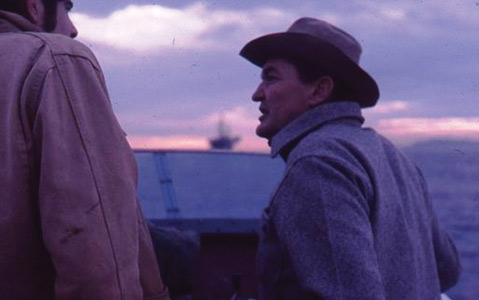Who Was Dick Smith?
Writer, Photographer, Naturalist, Conservationist

Richard J. “Dick” Smith was a writer, sculptor, woodworker, stonemason, photographer, naturalist, conservationist, and leather worker. Seven years after his death in 1977, his accomplishments were recognized when the 64,700-acre Dick Smith Wilderness was carved out of the Los Padres National Forest.
He was born in Minnesota in 1920, and as a young man attended the Minnesota School of Art and the University of Art in Jamestown, North Dakota. He taught art and worked for a Minneapolis newspaper while going to school. After serving on a carrier in the Pacific during World War II, he returned to the Minneapolis paper. A vacation in Santa Barbara in 1948 prompted him to move here, and he began his career at the Santa Barbara News-Press as a promotions manager, resident artist, and reporter.
He became entranced with the beauty, history, and lore of the Santa Barbara backcountry and the Los Padres. Without formal training in the natural sciences, he nevertheless set out on a determined course to learn everything he could about his newly discovered wilderness, especially the condor, that king of the California skies that was approaching extinction. In 1964, he coauthored with Robert Easton the book California Condor: Vanishing American. His additional writings on the condor were gathered together by his widow into the book Condor Journal. Smith’s years of tenacious work and research made him an internationally known authority on the condor.
During his Santa Barbara years, Smith did not neglect his art. He executed a sculpted mahogany mural, which for many years hung in the News-Press building. He illustrated a number of books, such as Walker Tompkins’s Goleta the Good Land. He made his own saddles, built his home, crafted furniture, created hand-carved doors for homes, and designed unique fireplaces and aquariums.
Smith was a tireless conservationist, delivering countless lectures that often featured his superb nature photography and using the pages of the News-Press as a forum. He was a prime mover in the creation of the 217,000-acre San Rafael Wilderness. He was a constant — and at times contentious — watchdog of the U.S. Forest Service. In 1968, he was honored by the California Conservation Council and in 1976 won an award for his articles on land management and forest use and their role in preventing forest fires. He was no stranger to the power of forest fires; he reported on the local fires for the News-Press and helped save a friend’s home during the massive Coyote Fire of 1964. His photo of an oil-soaked seabird graphically showed the impact the 1969 Santa Barbara oil spill had on area wildlife.
Despite signs of heart failure, Smith continued his research and work on the condor and hiked his beloved backcountry. Shortly after his death from a heart attack at age 56, the campaign began to have a wilderness area named after him. When the Dick Smith Wilderness became a reality as part of the California Wilderness Act, Smith joined the likes of Theodore Roosevelt and John Muir in having a piece of unspoiled wilderness set aside in his honor for the benefit of future generations.



